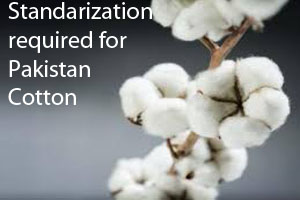
Standardization in Pakistan cotton can get good price in world market
YarnsandFibers News Bureau 2015-07-30 12:30:00 – IslamabadPakistani raw cotton is presently being traded at an average discount of 13 cents per pound in the international market due to lack of quality-based pricing system and non practicing of cotton standardization system, according to official sources.
Analysis of the current price differential vis-Ã -vis international market (Cotlook index A) and Karachi Cotton Association (KCA) shows it is over 16 cents per pound for 13 million bales - total $780 million, hence this price loss would be manifold in value added textile goods, the officials maintained.
On July 14, 2015 the New York Cotton Market price stood at 72.50 cents per pound, at China Cotton Index it was 91.25 cents per pound, Indian Cotton Index it was 72.40 cents per pound, while in Pakistan it was 56.16 cents per pound which is equivalent to Rs 5,017 per 40-kg or Rs 4,700 per maund. However, this price may touch Rs 6,000 per maund if its quality is improved.
Pakistan is the fourth largest cotton producing country but its cotton is considered as one of the most contaminated crop in the world. Exporters Guide by International Trade Centre categorizes Pakistani cotton in Group III where 90-100 bales are contaminated with 20-100g of contaminants per ton. Pakistani cotton is hand picked with good colour, but due to dry and hot weather conditions in cotton region is still traded at lower prices and considered as most contaminated cotton.
APTMA estimated over $1.4 billion loss due to cotton quality whereas National Textile University in a study estimated over $4 billion loss because of cotton contamination.
If proper standardisation is followed, over 45 percent of Pakistani cotton would be traded at premium. Pakistan's cotton is inheritably of good quality and a 6-year survey reveals that only 8-10 percent cotton fall in grade IV or below and over 90 percent in Grade III (Base grade) or better.
Cotton is traded on weight basis and farmers only cares about high yields and gives no attention to quality parameters and clean picking. Pickers on the other hand are paid for quantity of cotton picked in a day regardless of trash contents. On the other hand, Ginners mix high quality good and contaminated cotton to get a blend with moderate trash that loose its value.
Textile mills have installed cleaning equipment in their mills but have been paying no attention towards clean cotton production and standardization, as they get cheapest cotton for spinning, and quality production can be met through import of quality cotton from India or other countries, but reluctant to pay extra for quality to Pakistani farmers.
The government has circulated Cotton Standardisation Ordinance in 1994 and established Pakistan Cotton Standard Institute, framed rules and made necessary amendments in Cotton Control Ordinance 1966. The institute developed cotton standards for Pakistan and had them equalised/ synchronised with that of International (US and Liverpool) standards.
The institute has proved in a pilot program from one district of Punjab, where Pakistan cotton was traded at premium in Cotlook A Index, which shows the system is perfect, but need commitment from the stakeholders (Ginners and Textile producers).
Market Intelligence
Ask for free sample Report

experience
Customer Base
dedicated team
Countries Served Worldwide









